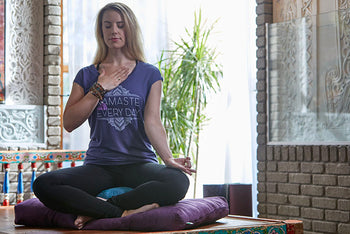7 Mindful Things You Can Do Today

When people practice mindfulness they say things like, "It makes me calm," "It softens my body," "It helps me be more aware of choice," or "I'm more clear on what matters." The question I love to follow with is, “What would the days, weeks and months ahead be like if there is more of this in your life?”
After this, there is often some kind of a-ha moment. They say, “Life would be really good.”
With that in mind, I want to share seven Mindful things you can do today!
Relax
It's true: mindfulness is not about relaxation. However, learning how to relax supports your mindfulness practice. In fact, it’s so important that I’m spending the first month of a six-month course in mindful living teaching people how to really calm their minds. When you do this, it not only supports your mindfulness practice, but your mindfulness practices also supports the awareness to do things that support ease. It’s an upward spiral! Find moments of awareness in the day to pause and soften your body, relax.
Use your breath
Our breath is the most portable anchor we have. It’s a wonderful practice to start your day, settling into your breath or even just taking a few deep breaths. If you’re feeling overwhelmed, see if you can notice where you experience it in the body while staying connected to your breath. Then see what you notice.
Pay attention to food
This was my introduction to mindfulness. Paying attention to food can not only help us find more joy in it, but it can also bring insight to foods we’re eating that we don’t even like or aren’t healthy for us. Use your food as an opportunity to drop into the life you’re living.
Move consciously
Most of us move in some way or another — why not bring more awareness to it? If you’re walking, sense your body walking; if you’re running, do the same. You can do this outside or in the office. Bringing mindfulness to movement can bring an appreciation to the fact that you can move at all and at the same time work to tune your nervous system.
Listen deeply
You may think I’m talking about sounds here…and in part, I am. Take moments in the day to pause, keep your eyes open or closed and really tune into the knowing of sounds coming and going. But I also mean listen deeply to the people around you, pay attention to them without distraction. The significance of connection we experience when we listen deeply is like a wonder drug for well-being. Connection as at the epicenter if happiness.
Forgive
One of the essential attitudes of mindfulness is learning how to let be and let go. Whenever you make a mistake, big or small, practice acknowledging the mistake, learn what you could do better next time and forgive yourself. It’s the past, no matter how hard you try, you can’t make a better past, but you can learn from it and begin again.
Rest in bed
From a guy who used to suffer from insomnia, this is one of my favorites. Bring mindfulness meditation to bedtime. Lay down, close your eyes, and spend the rest of the time resting with your breath. Improve your sleep, improve the world. Goodnight.
Life is an experiment. Play with these seven mindful things and see what shifts you being to notice.
Allow your experience to be your guide.
Warmly,
Elisha Goldstein
Explore Elisha’s 6-month workshop, A Course in Mindful Living today.
Elisha Goldstein, Ph.D. is cofounder of The Center for Mindful Living in West Los Angeles. He is a psychologist, author, and speaker who synthesizes the pearls of traditional psychotherapy with a progressive integration of mindfulness to achieve mental and emotional healing, offering practical strategies to calm our anxious minds, transform negative emotions, and facilitate inner peace. He is author of several books including Uncovering Happiness, The Now Effect, Mindfulness Meditations for the Anxious Travelerand co-author of A Mindfulness-Based Stress Reduction Workbook and MBSR Everyday. He also co-developed the CALM (Connecting Adolescents to Learning Mindfulness) with his wife Stefanie Goldstein, Ph.D.
Adapted from Mindfulness & Psychotherapy
Also in Blog

Body Peace & Personal Empowerment

Yoga for Swimmers: Poses for Strength and Mobility







